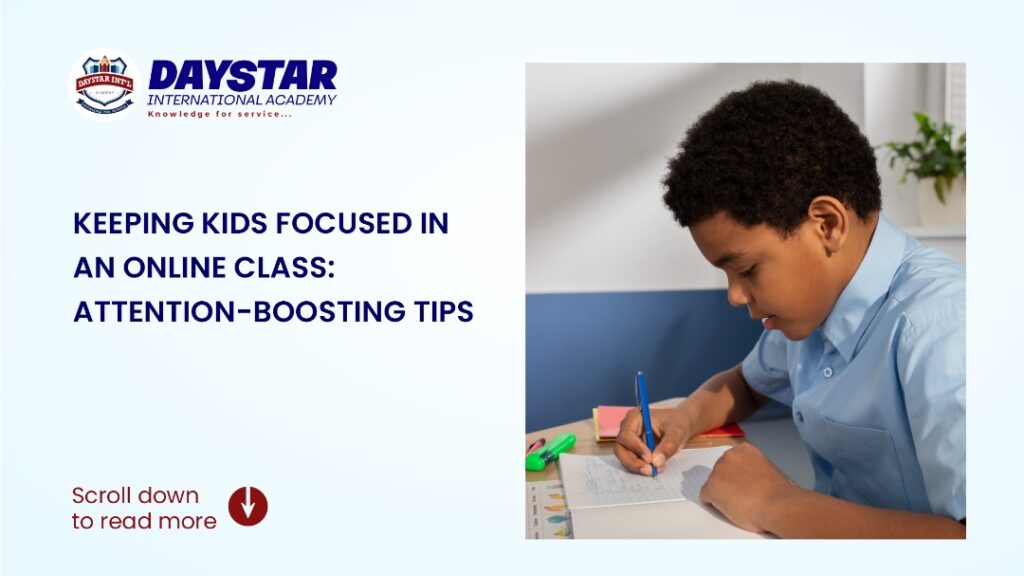
👀 Scene from the Screen
It’s math time, but your child is spinning in their chair.
The teacher’s explaining subtraction, but your child is fixated on a button on their shirt.
You whisper, “Focus!” for the third time in five minutes…
They blink up at you—clearly somewhere else.
If this sounds familiar, you’re not alone.
The truth is, staying focused is hard for adults, let alone six-year-olds staring at a screen.
But here’s the good news: focus isn’t a personality trait. It’s a skill. And like any skill, it can be developed—with the right strategies.
🧠 First, Why It’s So Hard to Focus Online
In a physical classroom, children are surrounded by structure: a teacher’s presence, peer cues, body language, walls, whiteboards, even bells.
At home, the brain faces a different world:
- Sofas that feel like nap time
- Toys within reach
- Siblings making noise
- A screen full of tiny faces instead of real ones
That’s a lot for young attention spans to navigate. So we make adjustments, not just in discipline, but in design.
🎯 Here’s What Actually Helps (and What Doesn’t)
✅ Do: Break the Day into Bite-Sized Segments
Kids focus best in short intervals. Between lessons, give them:
- 5-minute stretch breaks
- A snack or quick walk
- A chance to share what they just learned
Tiny breaks recharge their attention without derailing the day.
🚫 Don’t: Expect Adult-Level Focus
A six-year-old isn’t built to sit for 40 straight minutes.
If they’re fidgeting, it doesn’t mean they’re misbehaving, it often means they’re trying to stay engaged in the only way their body knows how.
What helps more: allowing subtle movement (e.g., a stress ball or seated wiggle) while keeping their eyes on the screen.
✅ Do: Make the Workspace Distraction-Proof
Keep only essentials on the table: laptop, books, a pencil case.
Put away toys, extra gadgets, or even loud wall posters.
Let them personalize the space with one drawing or encouraging message:
“You’re doing something amazing today!”
🚫 Don’t: Multitask Around Them
It’s tempting to do laundry or take calls nearby, but children absorb your presence.
If they sense you’re scattered, they feel unanchored too.
Even if you’re not sitting with them, being consistently available and calm helps them settle in.
✅ Do: Turn Class Time into Talk Time Afterward
Children focus better when they expect to share later.
Try asking:
- “What was your favorite part of today’s class?”
- “Was anything confusing?”
- “Did you ask or answer a question?”
Knowing they’ll be asked encourages them to listen more actively.
🚫 Don’t: Dismiss the Fidget
Some kids think by tapping their feet. Others focus better standing up.
As long as it doesn’t distract others, controlled movement can actually support concentration.
Try tools like:
- A standing desk converter
- A small foot roller
- Chair bands or quiet fidget toys
🧩 From a Daystar Parent:
“We used to battle over screen time and lessons. But once we let our son take charge of setting up his desk and take a dance break between classes, his mood changed. Now, he logs in without prompting.”
Sometimes, the trick isn’t more control, it’s more collaboration.
🌟 Final Word: Focus is Flexible
Children’s attention spans are elastic; they stretch with practice and the right environment. At Daystar, we teach focus not as a rule, but as a rhythm. With movement, motivation, and mindful design, we help learners tune in without tuning out their childhood energy. Your child isn’t distracted; they’re developing. Let’s guide that development together.

